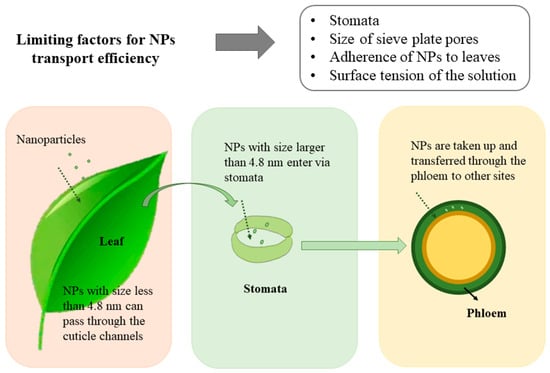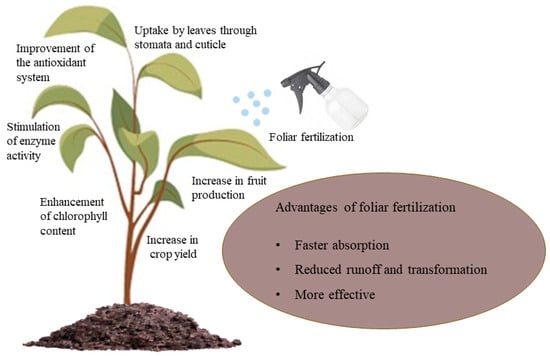Your browser does not fully support modern features. Please upgrade for a smoother experience.
Please note this is an old version of this entry, which may differ significantly from the current revision.
据估计,施用于土壤的常规常量养分N、P和K分别损失了40%至70%、80%至90%和50%至90%,造成相当大的资源损失。与传统肥料相比,纳米肥料体积小(1-100 nm)和比表面积高,具有控释、养分利用率高、成本低、环境污染相对较小等优点。纳米肥料的应用是农业研究的一个新兴领域,是传统肥料的有吸引力且经济的替代品,可以可持续地提高全球粮食生产力。叶面施肥是满足高等植物需求的一种流行方法。由于叶片施用量少,养分吸收比土壤快,环境污染相对较小,因此在植物中较受欢迎。可以看出,纳米肥和叶面施肥是目前关注的焦点,对纳米肥叶面施用的研究不如土壤施用广泛。
- nanofertilizers
- foliar fertilization
- heavy metal stress
- salt stress
- drought stress
1. The way of nano fertilizer entering the plant
Essential nutrients are most commonly applied to soil and plant leaves, and soil fertilization is more desirable and effective for larger nutrient needs[19]。In some cases, however, foliar fertilization has become a widespread and common method of crop management due to its more cost-effective and efficient characteristics[19].
The leaves of the plant protect the plant from water loss, pests and pathogens, while allowing gas exchange for the photosynthetic reaction[20].The surface of a leaf is usually composed of features: trichosomes, stomata, and phloem pores. NPs is absorbed by leaves in two ways, namely the cuticle pathway and the stomatal pathway[21](图2)。NPs with a diameter of less than 4.8 nm can enter the leaf directly through the cuticle channel, while NPs with a larger diameter can enter through the stomata. Due to the high density of the stomata itself, the stomatal pathway is considered to be a more efficient way to absorb NP[23].NF is absorbed by the stomata and transferred to the rest of the plant through the phloem. Nanoparticles can enter phloem in two ways, either directly from phloem cells or through the interstitiums of phloem cells [24]. Nano-fertilizer can promote the rapid acquisition of nutrients in plant growth parts, thereby increasing chlorophyll production, photosynthetic rate, and ultimately increase plant growth and development[25].

Figure 2.Methods and influencing factors of foliar application of nanoparticles.
2. 叶面纳米肥的农业应用
Nano-fertilizers are becoming more and more important in improving nutrient utilization efficiency due to their unique properties[28]。Rice fertilizer helps to release nutrients in a slow, controlled manner in order to deliver nutrients to the target location, thereby minimizing losses[29]。Nano-fertilizers have greater absorption and retention capacity than traditional fertilizers due to their small size [30]. Nano-fertilizer can improve the physiological and biochemical indexes of plants, such as photosynthetic rate and nutrient absorption efficiency, and enhance the defense system of plants[7]。Some studies have reported that zinc NFs has better physical and chemical properties and plays a positive role in promoting seed germination and plant growth [31\u201232]. Ahmed et al. have shown that sulfur nanofertilizers can not only reduce arsenic toxicity, but also improve the yield and quality of rice[33]。Hu et al. proved that low levels of TiO2NPs improved plant nutritional quality without causing significant oxidative stress [34]. In general, nano-fertilizer is more effective than traditional fertilizer and has good prospects for development.
Foliar fertilization is more effective than soil fertilization and is a useful method to meet the needs of higher tree species (Figure 3). Compared with foliar application, soil application is more harmful to the environment, and nano-fertilizer has lower bioavailability in the soil, while foliar application has lower environmental risk, so plants generally prefer foliar application of nano-fertilizer. Foliate fertilization has a low exposure dose, can be applied repeatedly, and can be applied regularly according to the weather to avoid nutrient loss. In addition, foliar application provides faster nutrient uptake than soil application[37].Figure 3 illustrates the advantages of foliar fertilization and its positive effects on plants.

Figure 3.Foliar application。
2.1. Improve crop yield and quality
Foliar application of nano-fertilizer can improve fertilizer utilization efficiency and crop yield and quality, and reduce adverse effects to a certain extent.
Zinc (Zn), as an essential micronutrient, has a major impact on plants, including protein, DNA, and RNA synthesis, and is also an essential cofactor for many antioxidant enzymes. There are many studies on the beneficial effects of zinc-based nano-fertilizer spraying on crops. Lorenzo et al found that ZnO NPs improved the growth and physiology of coffee due to the increased ability of ZnO NPs to penetrate leaves, and had a more positive effect on fruit and quality than ZnSO4 [Garcia-Lopez et al demonstrated, ZnO NPs (1000 mg/L and 2000 mg/L) sprayed on the leaf surface increased the antioxidant capacity of Habanos pepper fruit and significantly improved the fruit quality[38].Davarpanah et al. concluded that spraying a lower concentration of B or Zn nano-fertilizer on the leaf surface could promote the yield of pomegranates without affecting the characteristics of the fruit[40].Other studies have shown that leaf surface application of zinc nano-fertilizer not only increases the number of leaves and essential oil content, but also significantly improves plant growth, yield and nutrient content [41,42,43,44,45,46]. It can be seen that leaf surface application of zinc nano-fertilizer has a positive effect on the improvement of crop yield, quality, nutrient content and physiological parameters, and there may be no potential toxicity, but it should be noted that the optimal concentration of different plants may vary greatly.
2.2. Reduce environmental stress
Environmental stress effects will change ecosystem processes [53], destroy ecosystem balance, and then destroy the environmental balance related to food production, which may lead to crop yield reduction [54]. Heavy metals, salinization, drought, and high temperatures are all key environmental stressors that have serious impacts on global crop productivity and quality [55]. Various strategies have been sought to enhance the ability of plants to withstand these numerous environmental stresses [56]. Nano-fertilizer has high efficiency and slow release, and has become a suitable choice to reduce environmental stress effects [57\u201258] and promote crop cultivation in harsh environments [59\u201260]. A number of studies have confirmed the positive effects of NPs on plants under temperature stress, including improving photosynthetic capacity [61] and promoting growth and development [62]. However, heat stress has not been studied enough; Therefore, this paper introduces the application of nano-fertilizer in alleviating heavy metal stress, salt stress and drought stress, which are relatively concerned aspects in current research.
2.2.1. Heavy Metal Stress
重金属被植物吸收并积累在粮食作物中供人类和动物食用,严重危害作物生长和人类健康[63\u201264]。许多研究表明,纳米颗粒可以减轻植物对重金属的胁迫[65\u201266]。叶面施用硒和硅氮磷钾可缓解水稻的金属胁迫,提高糙米产量和品质[67]。叶面喷施ZnO NPs减轻了Cd污染,提高了玉米植株的株高和生物量以及叶绿素浓度[68]。叶面施用TiO2NPs可显著降低茎秆She含量,显著降低CD诱导的毒性。然而,在土壤中施用TiO 2NPs增加了玉米在CD污染土壤中对Cd的吸收[69]。综上所述,在叶片表面施用纳米肥对土壤重金属污染有缓解作用,在一定程度上可能比土壤施用更有用。然而,需要注意的是,重金属的存在可能会促进植物中纳米颗粒的吸收和富集,并产生共毒,导致食品安全问题[70]。
2.2.2. 盐胁迫
盐度被认为是限制全球作物产量的主要非生物胁迫之一。盐胁迫限制了生长,减少了生物量,导致叶绿素降解并改变了水的状态[73]。Abdelaal等人证明,叶面施用硅通过改善水态、提高光合速率、调节某些渗透压和植物激素以及增加抗氧化酶活性,减轻了盐胁迫对甜椒的不利影响[75].Perez-Labrada等人认为,叶面施用Cu纳米颗粒通过增加Na+/K+比值和刺激植物的抗氧化机制来增强耐盐性[77]。Sheikhalipour等研究证明,叶面施用Cs-Se NPs可以提高叶片光合色素含量,促进植物生产,并通过增加SOD、POD和CAT酶活性来减少盐胁迫下的氧化损伤[78]。Mustafa等发现,叶面喷施低剂量TiO2纳米颗粒可改善小麦的发芽特性以及水分和渗透潜力,并有助于提高植物对盐胁迫的耐受性[79]。纳米硅肥在缓解盐胁迫方面发挥积极作用[55,80,81]。例如,Alsaeedi等人表明,无定形二氧化硅纳米颗粒(Si NPs)有助于黄瓜植株在盐胁迫下的正常生长,在整个生长季节没有任何明显的脱水症状[82]。然而,叶面施用硅肥尚未得到充分研究,是一个新的研究方向。硅纳米颗粒作为喷涂其他纳米颗粒的涂层也相对较新。一项研究表明,盐胁迫下,ZnO NPs和Zno-Si NPs对豌豆植株的叶片施用效果不同[83]。较高浓度的ZnO NPs可产生一定的植物毒性作用,而Zno-Si NPs在生理条件下对植物无毒,在较高浓度下甚至有轻微的刺激作用。在叶片表面施用纳米肥是缓解盐胁迫的趋势之一。
2.2.3. 干旱胁迫
干旱条件也是制约作物产量的关键因素,对植物的形态、生理和分子水平造成许多不利胁迫[84],影响植物生长、生理和产量[85]。此外,随着干旱的恶化,土壤盐碱化和钙化加剧,进而导致生产力显着下降[91]。在缺水的半干旱热带地区,叶面施用纳米材料可能是提高产量的最佳选择,因为它需要大量的水来溶解并被根系吸收[92]。叶面施用纳米肥作为生长调节剂,可以促进干旱条件下作物的发育和生产力[92]。例如,喷叶ZnO NPs可以提高产量和作物品质[41,93]和种子营养品质[94],以及气孔导度和作物干旱胁迫指数[94]。此外,Moitazedi等发现,叶面施用锌肥可显著改善干旱胁迫对膜稳定指数(MSI)的影响[95]。研究还表明,在缺水条件下,在叶片表面喷施Fe和Zn纳米肥可以改善正常灌溉下豆类的生理特性和种子产量[85\u201296]。叶面施用K纳米螯合物可以改善生长、生理生化特性,增加定量和定性性状,减轻水分胁迫的负面影响[97]。在叶片表面施用镁纳米肥和壳聚糖肥可提高叶绿素总产量、种子产量和含油量,缓解干旱胁迫[98]。除了几种金属纳米肥料外,非金属纳米肥料也已用于许多应用。
综上所述,在非生物胁迫下在叶片表面施用纳米肥可以提高植物酶活性,增强植物抗氧化能力。这些改良可以提高作物对逆境的抵抗力,从而提高产量和质量。
This entry is adapted from the peer-reviewed paper 10.3390/nano13212906
This entry is offline, you can click here to edit this entry!
